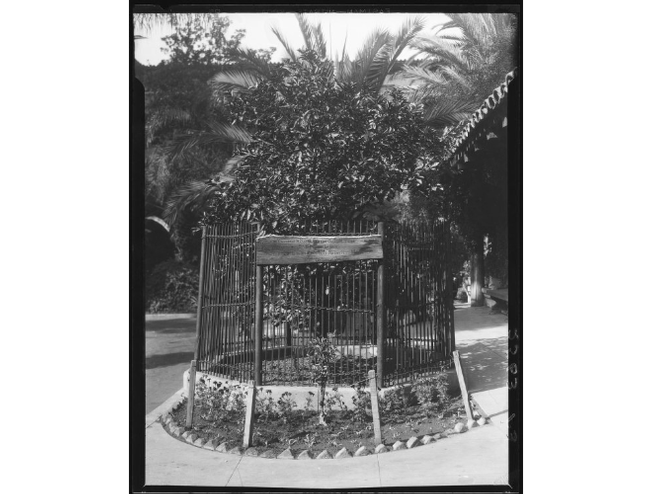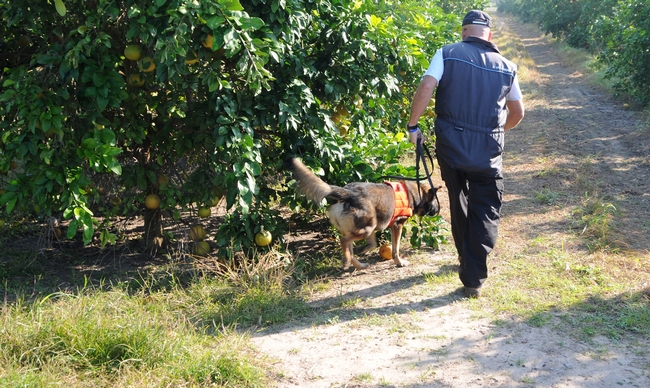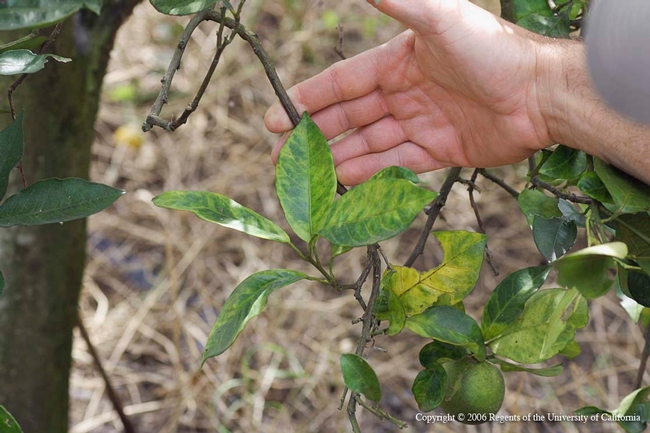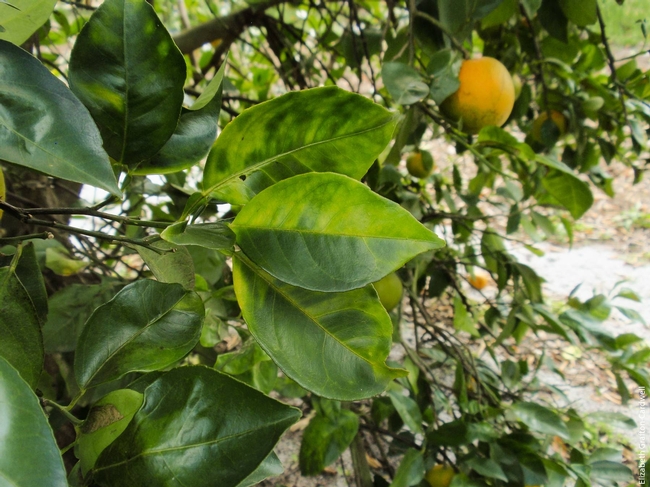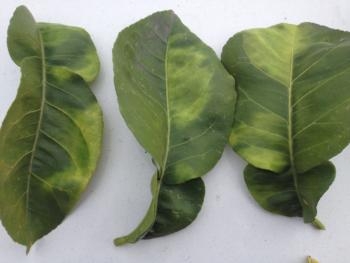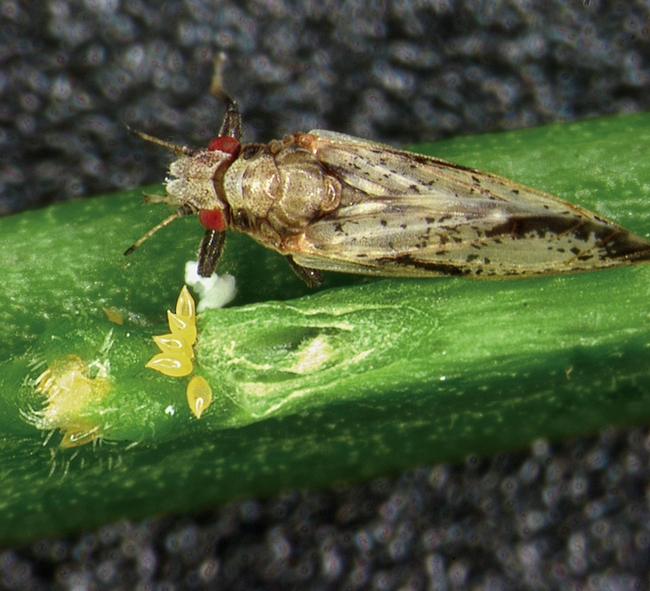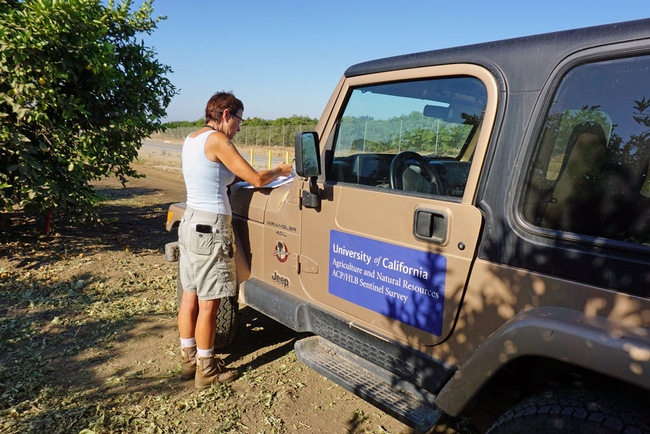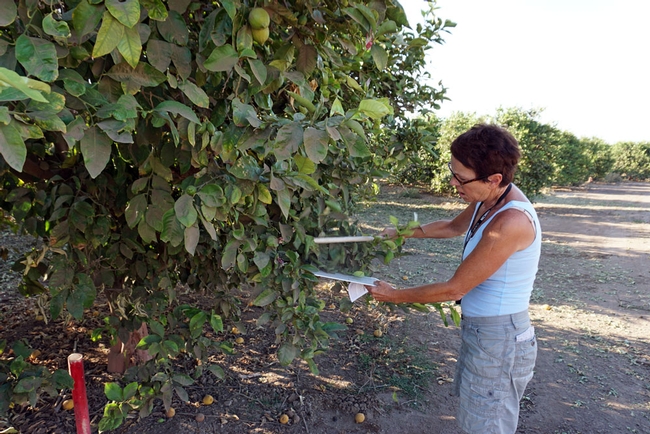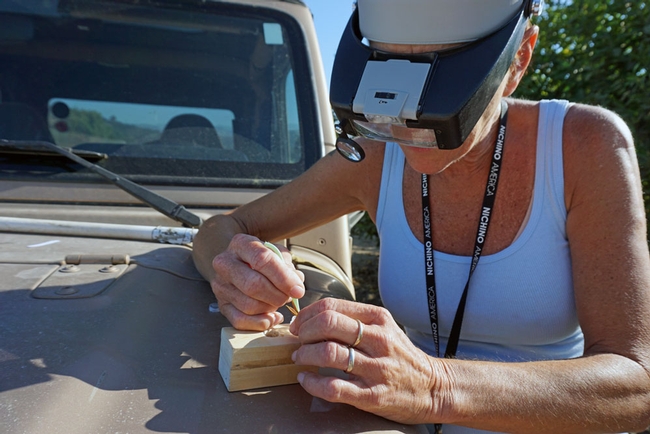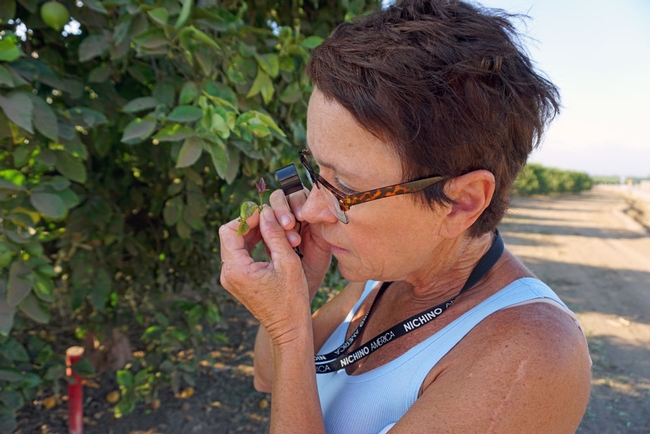Posts Tagged: Huanglongbing
Riverside Washington Navel gets additional protection
The city of Riverside is taking steps to protect a 143-year-old Washington Navel orange tree - the tree that parented most navel oranges alive today, reported the Riverside Press-Enterprise.
According to legend, the seedless and sweet Washington navel was an accidental mutant that appeared on the grounds of a Brazil monastery in the early 1800s. Tree clones were sent to USDA in Washington, D.C., and from there acquired by Eliza Tibbets, who tended the trees at her home in Riverside.
This month, city workers removed two trees that were planted near the iconic navel orange - a Marsh Grapefruit and another navel, which was planted in the 1940s and doesn't have the historical value. They have built a steel structure over the Washington Navel to support a transparent screen that will keep out Asian citrus psyllid, an invasive pest that spreads the devastating huanglongbing virus in citrus.
The measures to protect the tree were planned by a team that includes scientists from UC Riverside, the Citrus Research Board and the USDA, the article said.
For more information on the photo above, see visit this UCLA Library page.
Dogs enlisted to sniff out disease in citrus trees
The Citrus Research Board is arranging to bring specially trained dogs to the UC Lindcove Research and Extension Center to test their ability to sniff out the devastating citrus disease huanglongbing, reported Bob Rodriguez in the Fresno Bee.
CRB president Gary Schulz is working with the USDA, which is training dogs in Florida to identify trees with huanglongbing soon after the trees are infected. HLB has ravaged Florida's citrus industry. In California, the disease has been found about 800 Southern California backyard trees, but officials have so far managed to keep it out of the state's commercial orchards.
"The USDA has invested million of dollars in detector dogs and they have proven to be a credible diagnostic tool for early detection and screening trees," Schulz said.
HLB is spread by Asian citrus psyllids. Psyllids can pick up the the disease from infected trees and spread it to other trees as they feed. Symptoms may not show up in the tree until a year or two after it is infected. PCR (polymerase chain reaction) is the only way to positively identify huanglongbing infection in citrus. The process requires testing of many leaves or branches from the tree and may return a false negative if the samples selected for testing aren't infected, but other parts of the tree are.
Schulz said the HLB-detection dogs will start their California work in the southern part of the state before traveling north.
Pesticide spray ban could assist spread of huanglongbing disease
A Sacramento County Superior Court judge has ordered California agricultural officials to stop spraying pesticides in parks, schools and residents' backyards to control pests that threaten the ag industry, reported Gregory Mohan in the Los Angeles Times.
CDFA issued a statement saying it will consider appealing the case, and will continue to conduct spraying "in compliance with" state environmental laws.
Julia Mitric of Capital Public Radio spoke to UC Cooperative Extension entomology specialist Beth Grafton-Cardwell about the ruling. Grafton-Cardwell said it's a "huge setback."
She said spraying trees to control Asian citrus psyllid, which spreads the devastating huanglongbing disease of citrus, is crucial to buy time for scientists to develop long-term solutions to the threat.
"The state has managed to contain it to three counties in California — for the moment," Cardwell said. "But it's starting to spread very rapidly and so it's the most critical point in time to limit the psyllid spread."
How to check your citrus trees for a deadly disease and the pest that spreads it
The incurable citrus tree disease huanglongbing, or HLB, has been detected in Los Angeles and Orange counties and most recently in Riverside. The citrus disease is spread from tree to tree by Asian citrus psyllids, the insects that move the bacteria that cause huanglongbing.
Citrus trees infected with huanglongbing develop mottled leaves and produce fruit that is misshapen, stays green and tastes bitter. There is no known treatment for the disease, which usually kills the tree within three to five years, according to UC Cooperative Extension specialist Beth Grafton-Cardwell.
Huanglongbing, which is also known as citrus greening, has already devastated the citrus industries in Florida, Georgia, Louisiana, South Carolina and Texas.
You can help prevent this disease from destroying California's citrus as well as your own trees.
Look for yellowed leaves on citrus trees. Nutritional deficiencies can also cause citrus trees to have yellow leaves so it is important to know the difference. Nutrient deficiency causes a similar pattern of yellowing on both sides of the leaf. HLB causes blotchy yellow mottling and is not the same on both sides of the leaf.
To identify the Asian citrus psyllid and the disease symptoms of HLB, see the fact sheets, videos in English and Spanish and other resources at http://ucanr.edu/acp.
If you see any trees that display symptoms of huanglongbing, contact your local agriculture commissioner.
To learn about the latest research, visit UC ANR's new Science for Citrus Health website at http://ucanr.edu/sites/scienceforcitrushealth.
More resources on Asian citrus psyllids and huanglongbing:
- Science for Citrus Health http://ucanr.edu/sites/scienceforcitrushealth
- ACP/HLB Distribution and Management http://ucanr.edu/acp
- UC IPM Pest Note http://ipm.ucanr.edu/PMG/PESTNOTES/pn74155.html
- Newest Detection of Citrus Greening (HLB) is in Riverside //ucanr.edu/blogs/blogcore/postdetail.cfm?postnum=24776
- UC has boots on the ground in an unrelenting search for Asian citrus psyllid //ucanr.edu/blogs/blogcore/postdetail.cfm?postnum=24752
- Detecting Asian citrus psyllid video https://www.youtube.com/watch?v=QhQXL4bwnXI
UC has boots on the ground in an unrelenting search for Asian citrus psyllid
With two magnifying loops around her neck and a truck stocked with vials and tools for insect collection, Joanne O'Sullivan scouts Ventura County citrus orchards every day. She walks the perimeter, examining newly emerging leaves and tapping branches with a PVC wand to bat pests onto her clipboard.
O'Sullivan is one of four scouts hired and trained by UC Agriculture and Natural Resources scientists to carefully and continuously monitor citrus orchards for Asian citrus psyllid, an invasive pest in California that can spread the devastating huanglongbing disease.
In Florida, where the pest was left unchecked when it first invaded citrus growing regions, the disease swept through the state. Citrus production in the Sunshine State plummeted 60 percent in 15 years.
“We don't want to let that happen here,” said Beth Grafton-Cardwell, UC Cooperative Extension entomology specialist. Grafton-Cardwell hired O'Sullivan and her colleagues who monitor citrus in San Diego, Imperial, Riverside and San Bernardino counties to scour dozens of orchards to document how treatments to control ACP are working. Next year scouts will be added in Tulare and Kern counties.
When ACP are found, they are carefully bottled and sent to the lab to determine whether they carry the bacterium that causes huanglongbing disease.
The expansive ACP monitoring effort is funded by a $1.45 million multi-agency coordination grant from the USDA. The project funds promising tools and long-term solutions to reduce the spread of huanglongbing. Led by Neil McRoberts, a professor of plant pathology at UC Davis, the grant also provides funds for two other activities.
One is a collaboration with California Citrus Mutual to offer free citrus tree removal to homeowners in areas where HLB is known to occur. The second is modeling data from the CDFA HLB survey program, in which psyllids and symptomatic plant tissue are tested for the bacteria. Trees may have the disease but not show symptoms, so testing the psyllids is a more effective way to find infected trees. The modeling work will improve the ability to predict the locations of infected trees.
However, the main thrust is monitoring citrus treatments and their impacts on the ACP population with a team of scouts. A mix of conventional and organic farmers and growers who use biological integrated pest management programs to manage their orchards were recruited for the project. The farmers make ACP treatment decisions informed by research results that show the best treatments and timing.
“Most growers are coordinating their treatments to get a bigger bang for their buck,” Grafton-Cardwell said.
With just six months of data, the monitoring program has already yielded important information about Asian citrus psyllid.
“We're seeing more psyllids on the borders than the centers of groves,” Grafton-Cardwell said. “And so eventually, we will make recommendations that at certain times of year or when populations are low, the grower will only need to spray the borders of the grove."
This will reduce costs and the impact of pesticides on natural enemies.
"The early data have also revealed which chemicals are the most effective for psyllid control. We've found that organic growers need to be more aggressive in the frequency of treatments, because the organic insecticides are not as effective as conventional insecticides," she said.
At 8 of the 49 Ventura County ranches in the project, yellow sticky traps were placed in trees to monitor for ACP's natural enemies, including lady bugs, green lacewings, and Tamorixia radiata, tiny wasps from Pakistan that were released in California to battle ACP.
When O'Sullivan sees one of the natural enemies at work in the field, she pauses to observe the process.
“Sometimes I'll see a lacewing munching on an ACP and I'll say, ‘Go man, go!'” O'Sullivan said.


